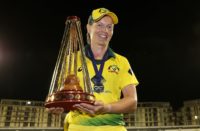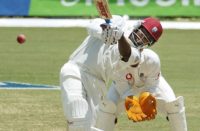Alison Mitchell offers a personal memory of one of cricket’s most important and respected figures who died earlier this month
Baroness Rachael Heyhoe Flint was the wittiest, most determined and energetic lady I’ve ever met. In the days after her passing, I was drawn to listening back to a lengthy interview I recorded with her in 2013 prior to the most recent Women’s World Cup. Her diary was a busy one, yet, in typical Rachael fashion, she found time, and did so by inviting me to join her at work at the House of Lords.
Rachael had been a Conservative peer for just over two years at that point. As she led me through security at the ‘other’ Lords, she was greeted with grins and respectful nods of “M’Lady” by staff and cloakroom attendants, who had presumably already fallen under the charms of Rachael’s warmth and cheeky humour.
“It amazes me,” she whispered, lowering her voice conspiratorially. “In my first week or two it was M’Lady this – and I’m thinking, who’s this M’Lady? I’m no more a Lady than – well, I don’t know who else to compare myself to. It amuses me, but then I think, oh well, perhaps it will make me behave myself a bit better.”
Rachael delighted in misbehaving, or perhaps, more accurately, in giving the impression she was misbehaving. As we sat on grand dining room style chairs in one of the wooden-panelled Residences Rooms, our feet resting on its plush red carpet, she gleefully described herself as an extrovert, as evidenced from the stories of how she pushed and pushed for recognition of the England women’s cricket team after she was made captain in 1966. There was the writing and sending of match reports to national newspapers, and there was the drive to have women cricketers seen on TV.
“I would be the cheeky one who would ring up the producer of A Question Of Sport and say, ‘you’ve never had anyone from women’s cricket on’,” she smiled. “They’d say, ‘oh well, yes – we might not find any archive material, but..’.”
There were some within the Women’s Cricket Association at the time who didn’t altogether appreciate Rachael’s efforts to drive publicity. She told me she believed she lost the captaincy in 1977 and was dropped from the team in order to be brought down a peg or two. She admitted to feeling extremely hurt at the time, but stressed she didn’t bear a grudge, even though it meant missing the World Cup that year; the second edition of the very tournament she had created with the philanthropist Sir Jack Hayward, who died in 2015.
Sir Jack didn’t agree with the circumstances surrounding Heyhoe Flint’s demotion and he withdrew his patronage of women’s cricket after supporting it for nearly seven years. Rachael told me that just before it all happened, she knew of a major sponsor who was prepared to help set up a one-day women’s county competition, with full television coverage. That idea was also withdrawn during the fall-out. Who knows how the development of women’s cricket may have been accelerated had such a televised competition been established.
As it was, Rachael resumed her rightful place in the team in 1979, having only lost two games as England captain – a rain-affected 1973 World Cup game against New Zealand in Exmouth (long before Duckworth and Lewis were on hand to calculate a fair target) and an ODI against Australia at Canterbury in 1976. Her Test record was 100 per cent.
Rachael would have told the tale of the advent of the Women’s Cricket World Cup a thousand times, but when I asked her about it, she launched readily into the story as if recalling it for the first time.
“I always blame it on a bottle of brandy,” she began, with a twinkle in her eye.
The brandy came a lot later in the story, in fact. It started in 1970 with her sending a hand-written letter completely out of the blue to Sir Jack, who was Wolverhampton-born but based in the Bahamas. “He was only plain ‘Jack’ when I first wrote to him,” laughed Rachael. “So look what I did for him!”
She had heard of Sir Jack’s philanthropic projects, in particular his penchant for the eccentric, and so she simply wrote, asking if he would like to sponsor the England women’s cricket team on a tour of the West Indies. She didn’t necessarily expect to hear back, but was both surprised and delighted to receive a phone call three weeks later from the man himself, saying: “I’ve got your letter right here, I’ll sponsor the England women’s cricket team.”
The pair became great friends and it was during a match in Sussex once, when Rachael was staying with Sir Jack’s family, that the infamous tipple came out one evening, and the idea of a Women’s World Cup was born.
“There we were, working our way through a bottle of brandy,” she chuckled. “He eventually said, ‘you know what we ought to do, we ought to have a World Cup of women’s cricket. Have another drink!’
“I thought, yes that’s a great idea, but who’s going to pay for it? He said, ‘I’ll sponsor it’, and that really was the seed of the idea.”
She went on to describe how Sir Jack took her to the silver vaults in the City of London to choose a World Cup trophy. They decided on a Georgian silver chalice (which Rachael reckoned had started life as a prize for an allotment competition). It was beautifully crafted and it became The Jack Hayward Trophy. It was presented at every World Cup between 1973 and 2005, the last tournament before the ICC took over the running of the women’s game and introduced a new trophy.
The original chalice now resides in the museum at Lord’s. When she paused to think about it, Rachael declared that the trophy should be awarded again, but this time to recognise a ‘moment of the tournament’ similar to how BBC Test Match Special awards a ‘Champagne Moment’ at the end of a Test match, in memory of former commentator Brian Johnston.
“That would please Sir Jack actually, because he’s got a great sense of humour,” she concluded.
It would, indeed, be apt.
Rachael’s achievements and contributions to cricket, football, community and charity have been well documented over the course of the last week. Some of her observations from our conversation in the Residences Room still hold true today. She lamented the chicken and egg scenario when it came to the coverage of women’s sport.
“It’s a vicious circle,” she remarked. “Because if you’re not known in the media, sponsors aren’t interested, and then how do you get people interested.”
Rachael was the first to make people interested. What she hadn’t foreseen four years ago, was the explosion in growth and profile that the women’s game would experience over this most recent World Cup cycle. She thought back then that women’s cricket, globally, had probably gone as far as it could.
She would have revelled, therefore, in the 122 per cent increase in prize money for last year’s ICC World T20, the crowd of over 25,000 who watched the Melbourne derby in the Women’s Big Bash League earlier this month, and the WBBL television audiences averaging 278,000 in Australia alone this season.
Worldwide coverage via television, radio and social media ought to make the 2017 Women’s World Cup, held in England, the most viewed and followed Women’s World Cup of all time. Rachael Heyhoe Flint started it all, and the ICC Women’s World Cup trophy should now be named after her in perpetuity.
Maybe then a sip of brandy to celebrate…
This piece originally featured in The Cricket Paper, January 27 2017
Subscribe to the digital edition of The Cricket Paper here















